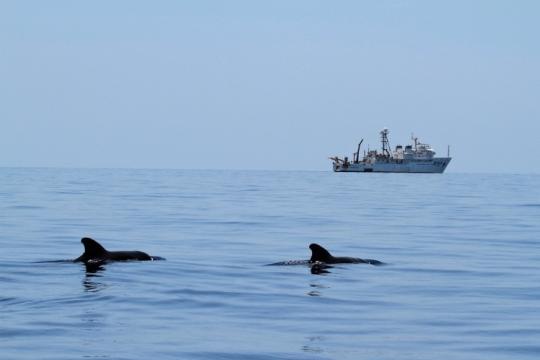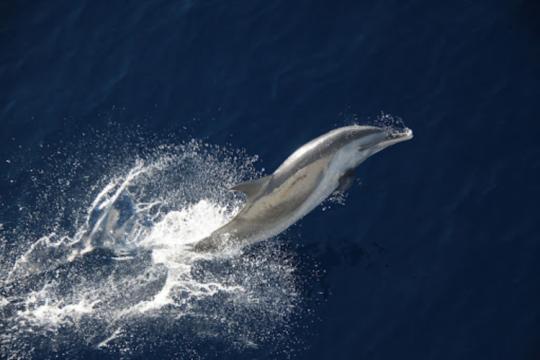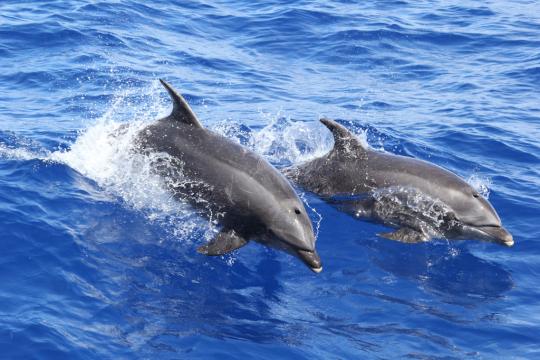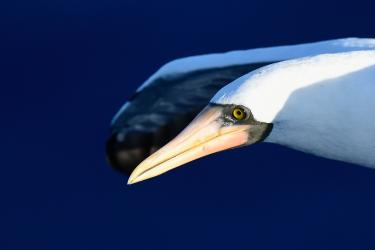Pantropical Spotted Dolphin
Stenella attenuata

Protected Status
Quick Facts
 Pantropical Spotted Dolphin. Credit: Marie C. Hill
Pantropical Spotted Dolphin. Credit: Marie C. Hill
Pantropical Spotted Dolphin. Credit: Marie C. Hill
About the Species
 Pantropical Spotted Dolphin. Credit: Marie C. Hill
Pantropical Spotted Dolphin. Credit: Marie C. Hill
Pantropical Spotted Dolphin. Credit: Marie C. Hill
Pantropical spotted dolphins are found in all tropical and subtropical waters worldwide. These relatively small dolphins are quite social and often associate with other dolphin species, including the rough-toothed dolphin, short-finned pilot whale, and spinner dolphin.
The tuna purse-seine fishery depleted the pantropical spotted dolphin population in the eastern tropical Pacific, and the northeastern offshore stock in the eastern tropical Pacific is considered depleted under the Marine Mammal Protection Act (MMPA). All pantropical spotted dolphins are protected under the MMPA.
NOAA Fisheries is committed to conserving and protecting pantropical spotted dolphins. Our scientists and partners use a variety of innovative techniques to study, learn more about, and protect this species.
Population Status
NOAA Fisheries estimates population size for each stock of pantropical spotted dolphin in its stock assessment reports. The Pacific northeastern offshore spotted stock is considered depleted under the MMPA.
Appearance
Pantropical spotted dolphins are relatively small, reaching lengths of 6 to 7 feet and weighing approximately 250 pounds at adulthood. They have long, slender snouts or beaks. Like the Atlantic spotted dolphin, pantropical spotted dolphins do not have spots at birth but accumulate them as they age until they are almost completely covered with overlapping spots. They are also distinguished by a dark cape or coloration on their backs—stretching from their head to almost midway between the dorsal fin and the tail flukes—and by a white-tipped beak.
Behavior and Diet
Pantropical spotted dolphins usually occur in groups of several hundred to 1,000 animals. They are considered quite social, often grouping with other dolphin species. Although their specific migratory patterns have not been clearly described, they seem to move inshore in the fall and winter months and offshore in the spring.
Pantropical spotted dolphins spend most of their day in shallower water between 300 and 1,000 feet deep. At night, they dive into deeper waters to search for prey. They feed primarily on mesopelagic cephalopods and fish.
Where They Live
Pantropical spotted dolphins can be found in all tropical and subtropical oceans worldwide. The depleted northeastern offshore spotted dolphin stock inhabits the eastern tropical Pacific Ocean, far out at sea. Coastal spotted dolphins are found within 100 miles of the coast. In addition, a Hawaiian stock occurs throughout the Hawaiian Islands.
In the Hawaiian archipelago, there are genetically distinct populations of pantropical spotted dolphins found between Hawaiߵi Island, Maui Nui, Oߵahu, and offshore. Animals from each population can travel 120 to 300 miles offshore, but they are generally found closer to the islands.
In the Northwest Atlantic Ocean sightings north of Cape Hatteras have been along the continental slope while in waters south of Cape Hatteras and in the Gulf of America sightings have been recorded in deeper offshore waters.
Lifespan & Reproduction
The maximum lifespan for pantropical spotted dolphins is 46 years. Maturity occurs around age 11. Mating and calving occurs year-round, with gestation lasting around 11 months. Lactation usually lasts 2 years, but it may be as few as 1 year. At 3 to 6 months old, however, calves will begin eating solid food. Calving intervals depend on the population, but they range from 2.5 to 4 years.
Threats
Entanglement
One of the main threats to pantropical spotted dolphins is becoming entangled or captured in commercial fishing gear. Entanglement is particularly threatening for the northeastern offshore spotted dolphin stock in the eastern tropical Pacific Ocean. Some species of tuna are known to aggregate beneath groups of northeastern offshore spotted dolphins in the eastern tropical Pacific. This close association led to the fishing practice of encircling a spotted dolphin group to capture the tuna concentrated below, to the detriment of the dolphin population, which were incidentally caught as bycatch in the nets.
Illegal Feeding and Harassment
Because pantropical spotted dolphins are common and abundant throughout the Hawaiian archipelago (where they are the second most frequently sighted species during nearshore surveys), interactions with people are a growing issue for the Hawaiian stock. Illegal feeding and harassment of these dolphins have been reported.
Hunting
Pantropical spotted dolphins are hunted for food in Asia, Indonesia, the Philippines, and parts of the Pacific.
Scientific Classification
| Kingdom | Animalia | Phylum | Chordata | Class | Mammalia | Order | Cetacea | Family | Delphinidae | Genus | Stenella | Species | attenuata |
|---|
Last updated by NOAA Fisheries on 03/06/2025
What We Do
Conservation & Management
All pantropical spotted dolphins are protected under the MMPA, with the Pacific eastern offshore stock listed as depleted. Our work protects and conserves pantropical spotted dolphins by:
- Reducing interactions with commercial and recreational fishing gear
- Minimizing harassment and illegal feeding
- Responding to dead, injured, or entangled dolphins
- Encouraging responsible viewing of wild dolphins
- Minimizing the effects of vessel disturbance, noise, and other types of human impacts
Science
Our research projects have helped us better understand pantropical spotted dolphins and the challenges they face. Our work includes:
- Undertaking stock assessments to determine the status of populations and/or sub-populations
- Examining population structure, abundance, and dynamics using a variety of research techniques, including photo-identification and genetics
- Conducting research to better understand how fishery interactions impact pantropical spotted dolphins
How You Can Help
Keep Your Distance
Be responsible when viewing marine life in the wild. Observe all dolphins and porpoises from a safe distance of at least 50 yards and limit your time spent observing to 30 minutes or less.
Don't Feed Wild Dolphins
Dolphins fed by humans lose their natural wariness and learn to associate people with food, causing them to beg for handouts and take bait and catch directly from fishing gear. This puts them at risk from vessel strikes and becoming entangled in or ingesting fishing gear. Dolphins may teach these behaviors to their young, thereby putting them at risk.
More on protecting wild dolphins and admiring them from a distance
Report Marine Life in Distress
Report a sick, injured, entangled, stranded, or dead animal to make sure professional responders and scientists know about it and can take appropriate action. Numerous organizations around the country are trained and ready to respond. Never approach or try to save an injured or entangled animal yourself—it can be dangerous to both the animal and you.
Learn who you should contact when you encounter a stranded or injured marine animal
Report a Violation
Call the NOAA Fisheries Enforcement Hotline at (800) 853-1964 to report a federal marine resource violation. This hotline is available 24 hours a day, 7 days a week for anyone in the United States.
You may also contact your closest NOAA Office of Law Enforcement field office during regular business hours.
Featured News
 Rice's Whale. Credit: NOAA Fisheries
Rice's Whale. Credit: NOAA Fisheries
Protecting Species While Planning for Offshore Wind Development in the U.S. Gulf of Mexico
 Pilot whales surface near the NOAA Ship Gordon Gunter. Credit: NOAA Fisheries/Melody Baran (Permit # 14450)
Pilot whales surface near the NOAA Ship Gordon Gunter. Credit: NOAA Fisheries/Melody Baran (Permit # 14450)
 A pantropical spotted dolphin surfacing along side the NOAA Ship Gordon Gunter. Credit: NOAA Fisheries (Permit No.14450)
A pantropical spotted dolphin surfacing along side the NOAA Ship Gordon Gunter. Credit: NOAA Fisheries (Permit No.14450)
 Pair of bottlenose dolphins. Credit: NOAA Pacific Islands Fisheries Science Center/Lisa Morse.
Pair of bottlenose dolphins. Credit: NOAA Pacific Islands Fisheries Science Center/Lisa Morse.
Management Overview
The pantropical spotted dolphin is protected throughout its range under the Marine Mammal Protection Act.
The Pacific northeastern offshore spotted stock is depleted under the Marine Mammal Protection Act.
Additionally, the pantropical spotted dolphin is listed under:
- Appendix II of the Convention on International Trade in Endangered Species of Wild Fauna and Flora (CITES)
- Annex II of the Protocol for Specially Protected Areas and Wildlife (SPAW)

Conservation Efforts
Reducing Interactions with Fishing Gear
Pantropical spotted dolphins are caught as bycatch in fishing gear, leading to serious injuries and death, especially in the eastern tropical Pacific. NOAA Fisheries works with fishermen, industry, non-government organizations, and academia to find approaches and strategies for reducing bycatch in U.S. fisheries.
Learn more about bycatch and fisheries interactions
Overseeing Marine Mammal Health and Stranding Response
We work with volunteer networks in all coastal states to respond to marine mammal strandings including all dolphins and porpoises. When stranded animals are found alive, NOAA Fisheries and our partners assess the animal’s health and determine the best course of action. When stranded animals are found dead, our scientists work to understand and investigate the cause of death. Although the cause often remains unknown, scientists can sometimes attribute strandings to disease, harmful algal blooms, vessel strikes, fishing gear entanglements, pollution exposure, and underwater noise. Some strandings can serve as indicators of ocean health, giving insight into larger environmental issues that may also have implications for human health and welfare.
Learn more about the Marine Mammal Health and Stranding Response Program
Marine Mammal Unusual Mortality Events
Pantropical spotted dolphins have been part of a declared unusual mortality event in the past. Under the Marine Mammal Protection Act, an unusual mortality event is defined as "a stranding that is unexpected; involves a significant die-off of any marine mammal population; and demands immediate response." To understand the health of marine mammal populations, scientists study unusual mortality events.
Get information on active and past UMEs
Get an overview of marine mammal UMEs
Minimizing Harassment and Illegal Feeding
As human interactions with wild dolphins increase, so does the risk of disturbing or injuring these animals. The Hawaiian stock of pantropical spotted dolphins is especially vulnerable to disturbance and harassment from tourists. NOAA Fisheries provides guidance on how to safely and responsibly view dolphins, including the following initiatives:
Learn more about the rules regarding feeding and harassing marine mammals in the wild
Implementing the Dolphin-Safe/Tuna Tracking and Verification Program
Pantropical spotted dolphins, like other marine mammals, may become bycatch in fisheries. Some species of tuna are known to aggregate beneath schools of northeastern offshore spotted dolphin stocks in the eastern tropical Pacific Ocean. This close association led to the fishing practice of encircling a spotted dolphin school to capture the tuna concentrated below. The Dolphin Protection Consumer Information Act established a national tuna tracking program to ensure that tuna imported into the United States meets certain requirements. The program helps ensure the safety of dolphins—such as the northeastern offshore spotted stock—during tuna fishing operations.
Learn more about the Dolphin-Safe/Tuna Tracking and Verification Program
Key Actions and Documents
Last updated by NOAA Fisheries on 03/06/2025
Science Overview
NOAA Fisheries and its partners are committed to research to help us better understand pantropical spotted dolphins and the challenges they face.

Stock Assessments
Determining the size of pantropical spotted dolphin populations helps resource managers determine the success of NOAA Fisheries’ conservation measures. Our scientists collect and present these data in annual stock assessment reports.
Shipboard Studies
NOAA’s Southwest Fisheries Science Center (SWFSC) has conducted over 10 cetacean and ecosystem assessment surveys to collect information on pantropical spotted dolphins in the eastern tropical Pacific Ocean. The primary objective of these surveys is to investigate trends in population size of those dolphin stocks most affected by the tuna purse-seine fishery. The project takes a multidisciplinary approach. The SWFSC collects data on cetacean distribution, group size, and group composition to determine dolphin abundance. We also collect data on dolphin behavior to determine how that behavior influences our ability to detect dolphin schools and how dolphins respond to research vessels. Oceanographic data are collected to characterize habitat and its variation over time. Data on the distribution and abundance of prey, fish and squids, seabirds, and marine turtles further characterize the ecosystem in which these dolphins live. Skin biopsies provide a database for investigations of stock structure, phylogenetic relationships, and the reproductive potential of female dolphins. Acoustic recordings supplement visual survey data and provide information for ongoing studies of cetacean vocalizations.
NOAA Fisheries also implemented an observer program in the early 1970s that has collected thousands of biological samples to study eastern tropical Pacific stock structure and to quantify life history characteristics of the population. NOAA Fisheries can use information from the assessment surveys and the observer program to improve conservation and management plans for this species.
More Information
Recent Science Blogs
Last updated by NOAA Fisheries on 03/06/2025
Outreach & Education
Dolphin Friendly Fishing Tips Sign
This sign is often posted near boat ramps, piers, docks, marinas, and waterfront parks.
Protect Wild Dolphins Sign
This sign is often posted near boat ramps, piers, docks, marinas, and waterfront parks.
Don't Feed Wild Dolphin Sign
This sign is often posted near boat ramps, piers, docks, marinas, and waterfront parks.
Last updated by NOAA Fisheries on 03/06/2025


